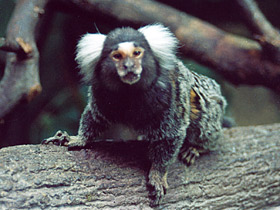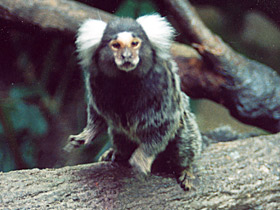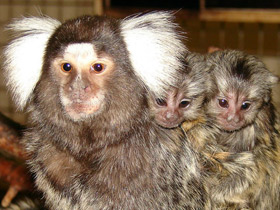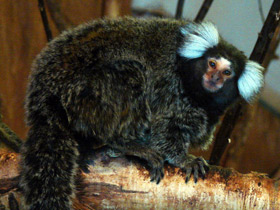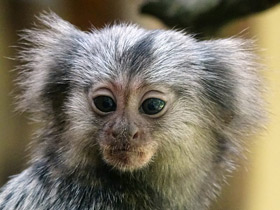The common marmoset (Callithrix jacchus) white-tufted marmoset or white-tufted-ear marmoset
Common marmoset видео
The common marmoset (Callithrix jacchus) also called white-tufted marmoset or white-tufted-ear marmoset is a New World monkey. It originally lived on the northeastern coast of Brazil, in the states of Piaui, Paraiba, Ceará, Rio Grande do Norte, Pernambuco, Alagoas, and Bahia.
Description
Callithrix jacchus is a species of platyrrhine primate of the family Callitrichidae. Males and females hardly differ in size, their body length is 12 to 15 cm, and tail length varies from 30 to 35 cm. Common Callithrix jacchus show great flexibility in habitat selection and inhabit a wide variety of forest ecosystems, including the most extreme: coastal forests; dry and seasonal inland forests; savannah forests. Callithrix jacchus is found around Baguia, and even ventures into plantations at the edge of the forest, where low shrubs grow.
Nutrition
Its diet consists of plant foods, based on tree sap, gum and some resins, as well as seeds, flowers, mushrooms, nectar and various fruits (e.g. bananas). Another important food source for Callithrix jacchus is insects and their larvae, to which it devotes 24-30% of its time. Due to their small body size, Callithrix jacchus can use insects to supplement their animal protein requirements. Their diet also includes snails, lizards, tree frogs, bird eggs, chicks and baby mammals.
Particularities
Callithrix jacchus are very emotional, capable of vividly expressing their feelings through facial expressions, the movement of tufts of hair on their heads and a variety of vocal signals. Several communication behaviours are important in the life of Callithrix jacchus. For example, by emitting specific odours, a pregnant female attracts and gathers other members of her group who participate in her parturition. Scent tags are applied to the fur from the anal sex gland.
Callithrix jacchus have several unique adaptations related to their feeding and arboreal lifestyle. They have claws (instead of the typical nails of other primates) on their hind toes. These claws help Callithrix jacchus move nimbly, like squirrels, around trees. They literally cling to vertical tree trunks, moving quickly along branches and jumping easily from branch to branch. Other features include their enlarged chisel-like incisors and specialised cecum, well adapted to their highly specialised diet. To extract sap, the common Callithrix jacchus gnaws the bark of trees, which stimulates the release of sap from the tree through wounds. As soon as the sap begins to flow, Callithrix jacchus licks it. Callithrix jacchus spends 20-70% of its daily feeding time on this activity. Callithrix jacchus often use holes previously hollowed out by them, or holes made and used by other animals, or use natural damage to trees, to obtain woody secretions. Throughout the day, these mobile monkeys spend 35% of their time foraging, 10% on social activities, 12% on foraging and 53% on resting. When Callithrix jacchus rests, it adopts an extended posture and may remain motionless for up to 30 minutes.
Social behaviour
Callithrix jacchus live in gregarious and family groups: they can be found in small groups of 3 to 8 individuals in trees and low bushes; they whistle and chirp like little birds. If conflicts arise between neighbouring family groups, they are usually resolved only by threatening shouts, without fighting. Their social hierarchy is peculiar: the dominant adult male dominates only other adult males, apparently without regard for adult females and subordinate juveniles. The alpha female behaves similarly towards other females, with no dictatorial attitude towards males or immature individuals.
Reproduction
The dominant pair is usually the mother of all pups in the group. Pregnancy duration in Callithrix jacchus is 144-146 days. Females usually give birth to twins (60%), triplets in 20%, one pup in 10% and very rarely four pups.
Callithrix jacchus tends to give birth to non-identical twins, which is unusual in primates. Newborn pups of Callithrix jacchus weigh about 25 g. Compared to adult animals, they are relatively large, as the total weight of newborns can be 20-27%, and sometimes up to 40%, of the mother's weight. When a calf is born, it immediately latches on to its mother's skin in the womb and grasps a nipple with its lips. At 17-21 days of age, it begins to occasionally descend from the adult's back. At 2-3 months of age, the male and female force the young to move on their own. Breeding continues until six months of age.
Ear tufts do not grow on the young until 6-9 months of age. The father usually takes the most active part in the care of the pups, which spend most of their time with him and not with the mother.
The males already 7-10 days after the birth of the cubs help the female in transporting the cubs, as the latter are large and difficult for the females to cope with two. Usually, not only the parents, but all members of the group carry the young and share pieces of food with them and the female that has given birth.
Females reach sexual maturity at 20-24 months, males in their second year of life.
Status
The common marmoset remains an abundant species and is not currently threatened, but its habitat had been degraded at a fast rate, with around 67% of the Cerrado region cleared for human use in the 1990s and around 80% cleared for cultivation more recently. In addition, marmosets are captured and traded as pets. Though popular as pets, they become difficult to control as they get older and are thus abandoned or killed. Common marmosets have also been used for medical experiments. They are used as such in Europe more so than in the United States, and are the most common nonhuman primates to be experimented on. They are used as model organisms in areas of research such as teratology, periodontal disease, reproduction, immunology, endocrinology, obesity, and aging.









